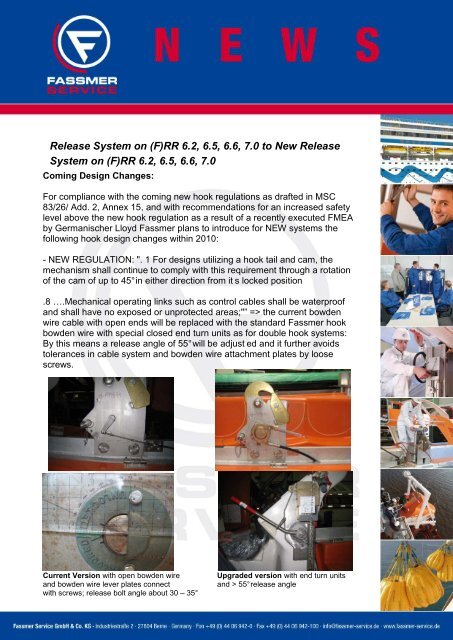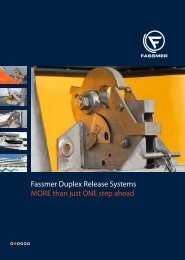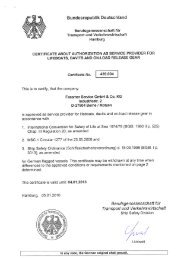Newsletter 05/2010 - Fassmer Service
Newsletter 05/2010 - Fassmer Service
Newsletter 05/2010 - Fassmer Service
You also want an ePaper? Increase the reach of your titles
YUMPU automatically turns print PDFs into web optimized ePapers that Google loves.
Release System on (F)RR 6.2, 6.5, 6.6, 7.0 to New Release<br />
System on (F)RR 6.2, 6.5, 6.6, 7.0<br />
Coming Design Changes:<br />
For compliance with the coming new hook regulations as drafted in MSC<br />
83/26/ Add. 2, Annex 15, and with recommendations for an increased safety<br />
level above the new hook regulation as a result of a recently executed FMEA<br />
by Germanischer Lloyd <strong>Fassmer</strong> plans to introduce for NEW systems the<br />
following hook design changes within <strong>2010</strong>:<br />
- NEW REGULATION: ". 1 For designs utilizing a hook tail and cam, the<br />
mechanism shall continue to comply with this requirement through a rotation<br />
of the cam of up to 45° in either direction from it s locked position<br />
.8 ….Mechanical operating links such as control cables shall be waterproof<br />
and shall have no exposed or unprotected areas;"” => the current bowden<br />
wire cable with open ends will be replaced with the standard <strong>Fassmer</strong> hook<br />
bowden wire with special closed end turn units as for double hook systems:<br />
By this means a release angle of 55° will be adjust ed and it further avoids<br />
tolerances in cable system and bowden wire attachment plates by loose<br />
screws.<br />
Current Version with open bowden wire<br />
and bowden wire lever plates connect<br />
with screws; release bolt angle about 30 – 35°<br />
Upgraded version with end turn units<br />
and > 55° release angle
Release System on (F)RR 6.2, 6.5, 6.6, 7.0 to New Release<br />
System on (F)RR 6.2, 6.5, 6.6, 7.0<br />
A locking pin as integral part of the hook will be introduced: - acts as FPD,<br />
preventing ANY hook opening when fitted - ensures correct and locked hook<br />
position when inserted - A new Anti- Blockage- System (ABS) prevents that<br />
the release lever can be operated as long as the locking pin is inserted, thus<br />
preventing the pin being blocked by the released hook<br />
Locking pin inserted (shown on<br />
a 10t hook): Hook is locked<br />
AND release bolt and lever can<br />
NOT be released to avoid<br />
blockage of hook under load<br />
(ABS-device, patent pending)<br />
Locking pin can ONLY be<br />
inserted if hook (1) AND Locking<br />
bolt (2) are in the correct position<br />
(top photo) and NOT if bolt is<br />
moved (lower photo)<br />
Once above design changes are approved by authorities, they can also be<br />
ordered for retro- fit to existing systems: with only few additional work during<br />
the regular <strong>Fassmer</strong>- <strong>Service</strong> the system is then compliant with the new<br />
coming rules and the latest <strong>Fassmer</strong> safety standard.<br />
Best Regards,<br />
<strong>Fassmer</strong> <strong>Service</strong> GmbH & Co. KG<br />
(issued electronically therefore not signed personally)








